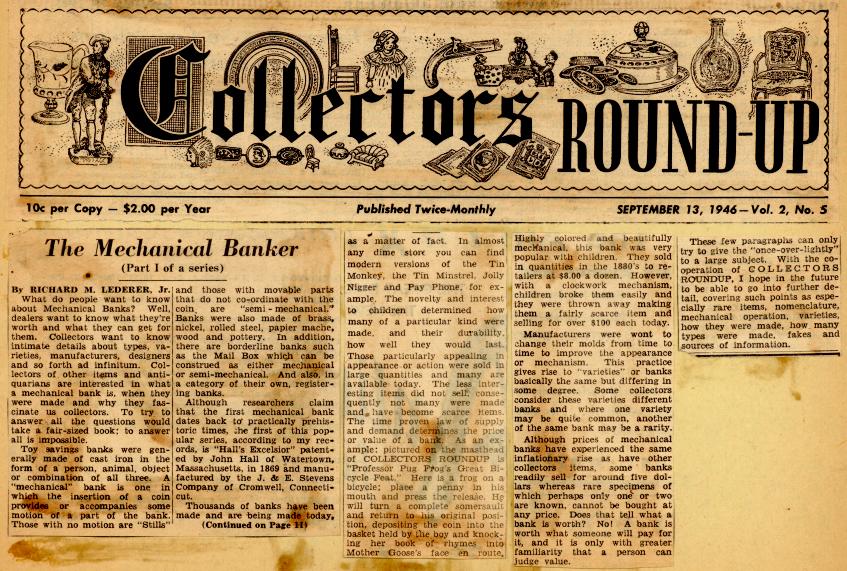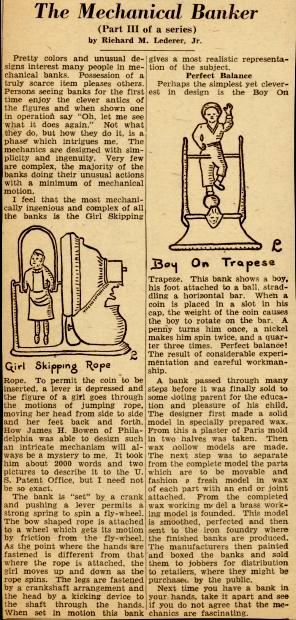|

| |

|
COLLECTORS ROUNDUP — September 13, 1946 — Vol. 2, No. 5 The Mechanical Banker
(Part I
of a series)
By Richard M. Lederer, Jr.
What do people want
to know about Mechanical Banks? Well, dealers want to know what they're worth
and what they can get for them. Collectors want to know intimate details about
types, varieties, manufacturers,, designers and so forth ad infinitum.
Collectors of other items and antiquarians are interested in what a mechanical
bank is, when they were made and why they fascinate us collectors. To try to
answer all the questions would take a fair-sized book; to answer all is
impossible.
Toy savings banks were generally made of cast iron in
the form of a person, animal, object or combination of all three. A "mechanical"
bank is one in which the insertion of a coin provides or accompanies some motion
of a part of the bank. Those with no motion are "Stills" and those with movable
parts that do not co-ordinate with the coin. are "semi-mechanical." Banks were
also made of brass, nickel, rolled steel, papier mache, wood and pottery. In
addition, there are borderline banks such as the Mail Box which can be construed
as either mechanical or semi-mechanical. And also, in a category of their own,
registering banks.
Although researchers claim that the first mechanical
bank dates back to practically prehistoric times, the first of this popular
series, according to my records, is "Hall's Excelsior" patented by John Hall of
Watertown, Massachusetts, in 1869 and manufactured by the J. & E. Stevens
Company of Cromwell, Connecticut.
Thousands of banks have been made and are being made
today, as a matter of fact. In almost any dime store you can find modern
versions of the Tin Monkey, the Tin Minstrel, Jolly Nigger, and Pay Phone, for
example. The novelty and interest to children determined how many of a
particular kind were made, and their durability, how well they would last. Those
particularly appealing in appearance or action were sold in large quantities and
many are available today. The less interesting items did not sell, consequently
not many were made and have become scarce items. The time proven law of supply
and demand determines the price or value of a bank. As an example: pictured on
the masthead of COLLECTORS ROUNDUP is "Professor Pug Frog's Great Bicycle Feat."
Here is a frog on a bicycle; place a penny in his mouth and press the release.
He will turn a complete somersault and return to his original position,
depositing the coin into the basket held by the boy and knocking her book of
rhymes into Mother Goose's face en route. Highly colored and beautifully
mechanical this bank was very popular with children. They sold in quantities in
the 1880's to retailers at $8.00 a dozen. However, with a clockwork mechanism,
children broke them easily and they were thrown away making them a fairly scarce
item and selling for over $100 each today.
Manufacturers were wont to change their molds from time
to time to improve the appearance or mechanism. This practice gives rise to
"varieties" or banks basically the same but differing in some degree. Some
collectors consider these varieties different banks and where one variety may be
quite common, another of the same bank may be a rarity.
Although prices of mechanical banks have experienced
the same inflationary rise as have other collectors items, some banks readily
sell for around five dollars whereas rare specimens of which perhaps only one or
two are known, cannot be bought at any price. Does that tell what a bank is
worth? No! A bank is worth what someone will pay for it, and it is only with
greater familiarity that a person can judge value.
These few paragraphs can only try to give the
"once-over-lightly" to a subject. With the cooperation of COLLECTORS ROUNDUP, I
hope in the future to be able to go into further detail, covering such points as
especially rare items, nomenclature, mechanical operation, varieties, how they
were made, how many types were made, fakes and sources of information.
|
|
COLLECTORS ROUNDUP — 1946 The Mechanical Banker
(Part III
of a series)
By Richard M. Lederer, Jr.
Pretty colors and
unusual designs interest many people in mechanical
banks. Possession of a truly scarce item pleases other. Persons seeing banks for
the first time enjoy the clever antics of the figures and when shown one in
operation say "Oh, let me see what it does again." Not what they do,
but how they do it, is a phase which intrigues me. The mechanics are designed
with simplicity and
ingenuity. Very few are complex, the majority of the banks doing their unusual
actions with a minimum of mechanical motion.
I feel that the most mechanically ingenious and complex
of all the banks is the Girl Skipping Rope. To permit the coin to be inserted, a
lever is depressed and the figure goes through the motions of jumping rope,
moving her head from side to side and her feet back and forth. How James H.
Bowen of Philadelphia was able to design such an intricate mechanism will always
be a mystery to me. It took him about 2000 words and two pictures to describe it
to the U. S. Patent Office, but I need not be so exact.
The bank is "set" by a crank and pushing a lever
permits a strong spring to spin a fly-wheel. The bow shaped rope is attached to
a wheel which gets its motion by friction from the flywheel. As the point where
the hands are fastened is different from that where the rope is attached, the
girl moves up and down as the rope spins. The legs are fastened by a crankshaft
arrangement and the head by a kicking device to the shaft through the hands.
When set in motion this bank gives a most realistic representation of the
subject.
Perfect Balance
Perhaps the simplest yet cleverest in design is the
Boy On Trapeze. This bank shows a boy, his foot attached to a ball, straddling a
horizontal bar. When a coin is placed in a slot in his cap, the weight of the
coin causes the boy to rotate on the bar. A penny turns him once, a nickel makes
him spin twice, and a quarter three times. Perfect balance! The result of
considerable experimentation and careful workmanship.
A bank passed through many steps before it was finally
sold to some doting for the education and pleasure of his child. The designer
first made a solid model in specially prepared wax. From this a plaster of Paris
mold in two halves was taken. Then wax hollow models were made. The next step
was to separate from the complete model the parts which are to be movable and
fashion a fresh model in wax of each part with an end or joint attached. From
the completed wax working model a brass working model is founded. This model is
smoothed, perfected and then sent to the iron foundry where the finished banks
are produced. The manufacturers then painted and boxed the banks and sold them
to jobbers for distribution to retailers, where they might be purchased by the
public.
Next time you have a bank in your hands, take it apart
and see if you do not agree that the mechanics are fascinating.
Also see:
1940s Richard M. Lederer, text
from manuscripts and letters
1946 Richard M. Lederer, Jr.
- Collectors
Roundup, September Article,
Part I
1946 Richard M. Lederer, Jr.
- Collectors
Roundup, December Article,
Part IV
1947 Richard M. Lederer, Jr. - Collectors
Roundup, March Article, Part V
1947 Richard M. Lederer, Jr. - Collectors
Roundup, April Article, Part VI
1950 IBM
Magazine

|
|



